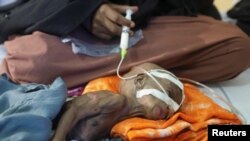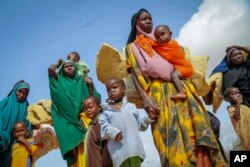UNICEF warns that an unprecedented number of children are likely to die in drought-stricken, famine prone Somalia without greater, immediate action from the international community to provide lifesaving assistance.
Somalia has endured four consecutive years of failed rains and is facing a possible fifth season of drought. This has destroyed peoples’ ability to feed themselves and has forced millions to uproot themselves in search of something to eat and essential basic relief.
The humanitarian crisis is having a particularly disastrous impact on children. UNICEF reports the number of severely acutely malnourished children is skyrocketing. In August alone, it reports that 44,000 children with severe acute malnutrition were admitted to health facilities for emergency treatment.
Speaking from Dolow, Somalia, UNICEF spokesman James Elder said this means today in Somalia, a child is admitted to a health care facility every single minute of every single day.
“Severely acutely malnourished children are 11 times more likely to die of diarrhea and measles than are well-nourished children. With rates like those, I have mentioned, Somali is really on the brink of a tragedy at a scale not seen in decades. And of course, the children behind what is a staggering, slightly appalling statistic are those who make it to a treatment center,” he said.
Elder notes that many people are prevented from getting the help they need because of ongoing instability in the country and the dangers posed by the Islamist militant al-Shabab group. In response, he said UNICEF is deploying mobile teams to find and treat malnourished children in hard-to-reach locations.
“When people speak of the crisis facing Somalia and Somalians today, it has become very common to make these frightful comparisons to the famine, of course, of 2011 when around 260,000 people — half of those children -- died. However, everything I am hearing on the ground from nutritionists to famine experts to pastoralists is that things today actually, unfortunately, look worse," said Elder.
The U.N. Office for the Coordination of Humanitarian Affairs estimates 7.8 million people in Somalia are affected by the drought, including more than 1.1. million displaced people.
OCHA reports famine is projected in Baidoa and Burhakaba districts in Bay Region between now and December if humanitarian aid does not reach people most in need. As of now, 45 percent of the U.N.’s $2.26 billion appeal has been funded.










